Wavelet Time-Frequency Analysis on Bridge Resonance in Train-Track-Bridge Interactive System
Abstract
:1. Introduction
2. Establishment and Solution of Motion Equation for Train–Track–Bridge Interactive System Based on Wavelet Computational Properties
2.1. Wavelet Time-Frequency Analysis Theory and Relevant Computational Deduction
2.2. Establishment of Motion Equation for the Train Subsystem
2.3. Establishment of Motion Equation for the Track–Bridge Subsystem

2.4. Intersystem Iteration Solution Procedures
3. Time-Frequency Interaction Analysis on the Train–Track–Bridge System
3.1. Analysis of Methodological Correctness
3.2. Division of the Band from Resonant to Nonresonant Bridge Condition
3.3. Time-Frequency Analysis from Excitation to Bridge Response
3.3.1. On the Resonant Bridge
- For the excitation scalogram in Figure 7a,c,e, there are only three loading frequency orders in yellow under all the speed conditions, reflecting that the influence of higher–order loading frequency is basically negligible. Frequency values of each order are integer multiples of the first–order loading frequency, respectively, while the order with the frequency band equal to the bridge natural frequency (6.5 Hz) is defined as the resonance–triggering band. Among them, the first–order loading frequency is the largest, containing the highest signal energy, followed by the third–order and second–order. The scalogram value corresponding to each loading frequency order firstly increases and then decreases with the process of entering and leaving the bridge. The scalogram value of each loading frequency order will not change with the increase in speed, but its frequency and the bandwidth between each order frequency will increase with the increase in speed.
- For the response scalogram in Figure 7d, the triggered resonance band, corresponding to the second–order response frequency, is not completely dominant for the entire response with the existence of other orders of response frequency. In contrast, for Figure 7b,e, only the triggered resonance bands are visible and completely dominate the entire response. The scalogram value of the triggered resonance band in Figure 7b is more significant than the one in Figure 7e.
- In general, the bridge resonant response is stationary while the train is crossing the bridge. The resonance–triggering band is included within each order of loading frequency, while the triggered resonance band will dominate the bridge response only when the signal energy of the corresponding triggering band is significant. Typically, the resonance–triggering band which is in the first–order loading frequency and equals the natural frequency of bridge will lead to the most intense bridge resonant response.
3.3.2. On the Resonantly Transitional Bridge
- For the excitation scalogram in Figure 8a,c,e,g, the time–frequency band distributive regulations are almost identical to Section 3.3.1. The frequency band circled in white is defined as the quasi–resonance–triggering band because the frequency components within this band are close to the bridge natural frequency (6.5 Hz).
- For the response scalogram in Figure 8b,d,f,h, the triggered quasi–resonance bands completely dominate the entire response because they are close to the bridge natural frequency. Simultaneously, the sorting of scalogram values in descending order is listed as (f) > (h) >> (b) > (d).
- In general, the bridge’s resonantly transitional response is stationary while the train is crossing the bridge. The quasi–resonance–triggering band is included within each order of loading frequency and in this case, the triggered quasi–resonance band will dominate the bridge response. Typically, the closer the quasi–resonance–triggering band is to the natural frequency of the bridge, the more the bridge resonant response will be intensified. Therefore, reasonably controlling train speed can crucially help to keep the bridge away from intense quasi–resonant response.
3.3.3. On the Nonresonant Bridge
- For the excitation scalogram in Figure 9a,c,e, the time–frequency band distributive regulations are almost identical to Section 3.3.1 and Section 3.3.2. Owing to the train speed which is situated in the nonresonant bridge condition according to Figure 6 in Section 3.2, the quasi–resonance and resonance–triggered band disappears from the excitation scalogram.
- For the response scalogram in Figure 9b,d,f, there is a “peak staggering” phenomenon between the transient response band and the steady state response band. During this period, the first wheel set of the vehicle acts on the bridge which has no time to produce a steady state response, so free vibration whose frequency equals the bridge natural frequency will occur within the transient response band. When the moving load becomes stably periodic, the bridge presents a steady state response, and the scalogram value will increase to the first–order response frequency contributed by the first–order loading frequency, while the scalogram value is attenuated in the transient response band. At the moment when the last wheel set leaves the bridge, with the end of wheel set periodic loading, the steady state response weakens and is gradually replaced by the transient response. Therefore, a higher scalogram value is reintensified in the transient response band after the train leaves the bridge. With the increase in train running speed, the scalogram values of steady state response and transient response are slightly higher than those under low–speed conditions.
- In general, the nonresonant response of the bridge is mainly composed of the steady–state response contributed by the loading frequency component, while the transient response is contributed by the bridge natural vibration frequency. The response is steady state when the train moves on the bridge and transient at the initial stage and later stage of the train entering and leaving the bridge. In addition, the intensity of nonresonant response of the bridge is related to the train speed.
3.4. Evolutionary Reaction Analysis from the Bridge on the Track and the Train Subsystem
- By comparison, between Figure 10a,b, the frequency band for the car body response is extremely scattered and there is no significant and stable time–frequency band which can clearly present the stable bridge natural frequency (6.5 Hz). In contrast, it can only be seen that the scalogram value increases with the increase in the train speed which is positively correlated to the velocity and the acceleration of track irregularity. Therefore, the car body response is dominated by the track irregularity excitation which has masking effect on the bridge response.
- By comparison between Figure 10c,d, the high frequency band for the mid–rail presents the multiple peaks fluctuating phenomenon, which signifies the periodic loading process conducted by the continuous movement of multiple vehicle elements. Simultaneously, with the increase in train speed, the former high frequency band will move upwards to a higher frequency band. In terms of the low frequency band within the sub–windows, both of them contain the components of bridge natural frequency, which signifies that the feedback comes from the bridge response and in particular, will be intensified under the bridge resonant condition.
- Figure 10e,f share the similar time–frequency characteristics to (c) and (d). The feedback which comes from the bridge response will be intensified under the bridge resonant condition. Particularly, the sleepers are closer to the bridge than the rail; therefore, the feedback on the sleepers is more intense than that on the rail.
- In general, within the low–frequency band, the resonant bridge will have a more significant impact on the track subsystem, especially for the substructure closer to the bridge deck, than the nonresonant one, while the impacts from the bridges almost neglect the car body.
4. Discussion
- The train–track–bridge interactive model established in the article is 2D, only involving the vertical displacement and the torsional pitching. Hence, to make the results closer to the realistic project, the study will be extended in a 3D train–track–bridge interactive model with more DOFs.
- The article is lacking in the data measured on site to validate the theoretical results and rectify the model. Thus, the future study will try to launch the real measurement both on the train and on the bridge.
- The article neglects that the track irregularity is actually a type of random excitation which will randomize the response of the train–track–bridge interactive system. In this case, the future study will combine the random vibration theory with the wavelet time–frequency analysis so as to make this method feasible for the actual damage detection on the train–track–bridge interactive system.
5. Conclusions
- The bridge resonant response is stationary while the train is crossing the bridge. The resonance–triggering band is included within each order of loading frequency, while the triggered resonance band dominates the bridge response only when the signal energy of the corresponding triggering band is significant. Typically, the resonance–triggering band, which is located in the first–order loading frequency and equals the natural frequency of bridge, will lead to the most intense bridge resonant response.
- The bridge’s resonantly transitional response is stationary while the train is crossing the bridge. The quasi–resonance–triggering band is included within each order of loading frequency and will dominate the bridge response. Typically, the closer the quasi–resonance–triggering band is to the natural frequency of bridge, the more the bridge response will be intensified.
- The nonresonant response of the bridge is mainly composed of the steady state response contributed by the loading frequency component and the transient response contributed by the bridge natural vibration frequency. The response is steady state when the train moves on the bridge forming periodic loading, while transient at the initial stage and later stage of the train entering and leaving the bridge. Staggering domination between the steady state and the transient response is the main phenomenon for the nonresonant bridge.
- Within the low–frequency band, the resonant bridge will have more significant impact on the track subsystem, especially for the substructure closer to the bridge deck, than the nonresonant one, while the impacts from the bridges almost neglect the car body even under the resonant bridge condition.
Author Contributions
Funding
Institutional Review Board Statement
Informed Consent Statement
Data Availability Statement
Acknowledgments
Conflicts of Interest
References
- Xia, H.; Zhang, N.; Guo, W. Dynamic Interaction of Train-Bridge Systems in High-Speed Railways; Springer: Berlin/Heidelberg, Germany, 2018. [Google Scholar] [CrossRef]
- Li, J.; Su, M. The resonant vibration for a simply supported girder bridge under high-speed trains. J. Sound Vib. 1999, 224, 897–915. [Google Scholar] [CrossRef]
- Kumar, S.; Kolekar, T.; Patil, S.; Bongale, A.; Kotecha, K.; Zaguia, A.; Prakash, C. A Low-Cost Multi-Sensor Data Acquisition System for Fault Detection in Fused Deposition Modelling. Sensors 2022, 22, 517. [Google Scholar] [CrossRef] [PubMed]
- Ju, S.; Lin, H. Resonance characteristics of high-speed trains passing simply supported bridges. J. Sound Vib. 2003, 267, 1127–1141. [Google Scholar] [CrossRef]
- Xia, H.; Zhang, N.; Guo, W. Analysis of resonance mechanism and conditions of train–bridge system. J. Sound Vib. 2006, 297, 810–822. [Google Scholar] [CrossRef]
- Ülker-Kaustell, M.; Karoumi, R. Influence of non-linear stiffness and damping on the train-bridge resonance of a simply supported railway bridge. Eng. Struct. 2012, 41, 350–355. [Google Scholar] [CrossRef]
- Pereira, A.; Pimentao, J.P.; Sousa, P.; Onofre, S. Smart sensor data acquisition in trains. In Proceedings of the 43rd Annual Conference of the IEEE Industrial Electronics Society, Beijing, China, 29 October–1 November 2017; pp. 5598–5603. [Google Scholar] [CrossRef] [Green Version]
- Cano-Moreno, J.D.; De Pedro, J.M.M.S.; Villagrá, M.R.; Gil González, R. Design and development of a data acquisition system to monitor comfort and safety in railways. Insight-Non-Destr. Test. Cond. Monit. 2021, 63, 47–54. [Google Scholar] [CrossRef]
- Matsuoka, K.; Tanaka, H.; Kawasaki, K.; Somaschini, C.; Collina, A. Drive-by methodology to identify resonant bridges using track irregularity measured by high-speed trains. Mech. Syst. Signal Process. 2021, 158, 107667. [Google Scholar] [CrossRef]
- Ruzzene, M.; Fasana, A.; Garibaldi, L.; Piombo, B. Natural Frequencies and Dampings Identification Using Wavelet Transform: Application to Real Data. Mech. Syst. Signal Process. 1997, 11, 207–218. [Google Scholar] [CrossRef]
- Piombo, B.; Fasana, A.; Marchesiello, S.; Ruzzene, M. Modelling and Identification of The Dynamic Response of A Supported Bridge. Mech. Syst. Signal Process. 2000, 14, 75–89. [Google Scholar] [CrossRef]
- Moyo, P.; Brownjohn, J. Detection of anomalous structural behaviour using wavelet analysis. Mech. Syst. Signal Process. 2002, 16, 429–445. [Google Scholar] [CrossRef] [Green Version]
- Meo, M.; Zumpano, G.; Meng, X.; Cosser, E.; Roberts, G.; Dodson, A. Measurements of dynamic properties of a medium span suspension bridge by using the wavelet transforms. Mech. Syst. Signal Process. 2006, 20, 1112–1133. [Google Scholar] [CrossRef]
- Chatterjee, P.; Obrien, E.; Li, Y.; González, A. Wavelet domain analysis for identification of vehicle axles from bridge measurements. Comput. Struct. 2006, 84, 1792–1801. [Google Scholar] [CrossRef] [Green Version]
- Hester, D.; Gonzalez, A. A wavelet-based damage detection algorithm based on bridge acceleration response to a vehicle. Mech. Syst. Signal Process. 2012, 28, 145–166. [Google Scholar] [CrossRef] [Green Version]
- Pacheco-Chérrez, J.; Cárdenas, D.; Probst, O. Measuring Crack-type Damage Features in Thin-walled Composite Beams using De-noising and a 2D Continuous Wavelet Transform of Mode Shapes. J. Appl. Comput. Mech. 2020, 7, 355–371. [Google Scholar] [CrossRef]
- Jiang, Q.; Suter, B.W. Instantaneous frequency estimation based on synchrosqueezing wavelet transform. Signal Process. 2017, 138, 167–181. [Google Scholar] [CrossRef]
- Chang, H.-H. Non-intrusive fault identification of power distribution systems in intelligent buildings based on power-spectrum-based wavelet transform. Energy Build. 2016, 127, 930–941. [Google Scholar] [CrossRef]
- Choose a Wavelet [DB/OL]. 2020. Available online: https://www.mathworks.com/help/wavelet/gs/choose-a-wavelet.html#d120e1132 (accessed on 16 May 2022).
- Staszewski, W.J.; Wallace, D.M. Wavelet-based Frequency Response Function for time-variant systems—An exploratory study. Mech. Syst. Signal Process. 2014, 47, 35–49. [Google Scholar] [CrossRef]
- Zhang, N.; Zhou, Z.; Wu, Z. Safety evaluation of a vehicle–bridge interaction system using the pseudo-excitation method. Railw. Eng. Sci. 2021, 30, 41–56. [Google Scholar] [CrossRef]
- Xiang, J.; Jiang, Z.; Chen, X. A class of wavelet-based Rayleigh-Euler beam element for analyzing rotating shafts. Shock. Vib. 2011, 18, 447–458. [Google Scholar] [CrossRef]
- Xiang, J.; Li, D.-J.; Zeng, Q.-Y. Simulation of spatially coupling dynamic response of train-track time-variant system. J. Central South Univ. Technol. 2003, 10, 226–230. [Google Scholar] [CrossRef]
- Zhang, N.; Xia, H. A Vehicle-Bridge Interaction Dynamic System Analysis Method Based on Inter-System Iteration. China Railw. Sci. 2013, 34, 32–38. [Google Scholar] [CrossRef]
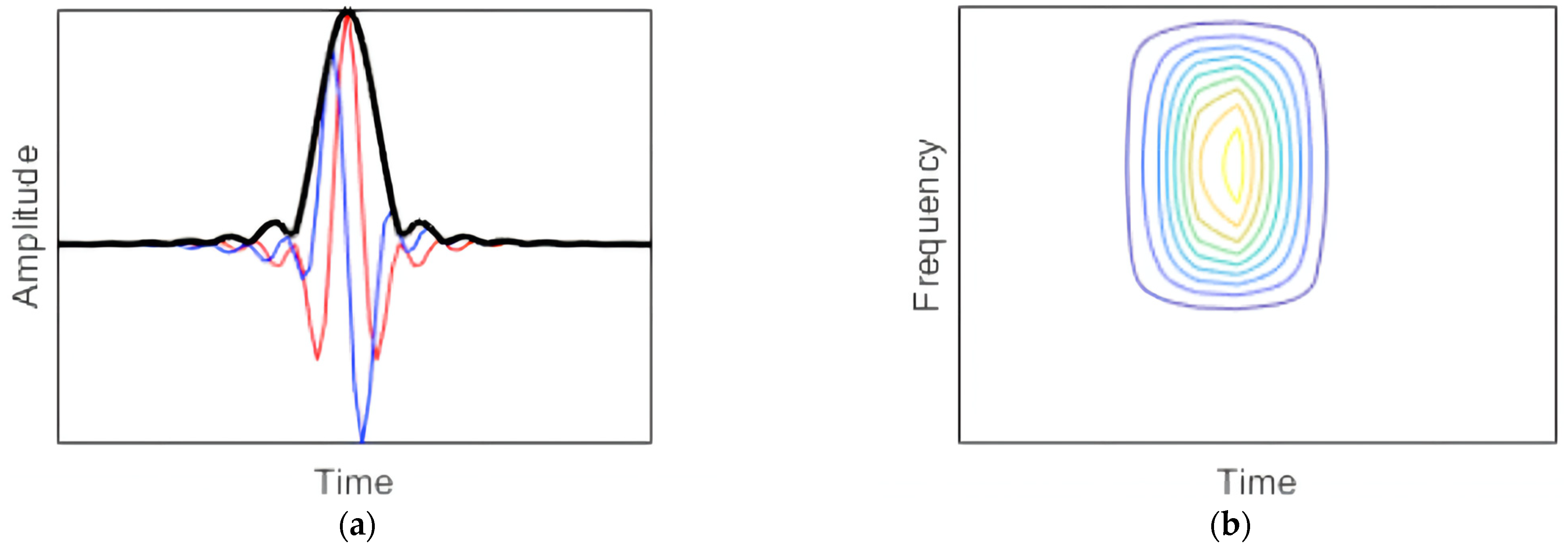



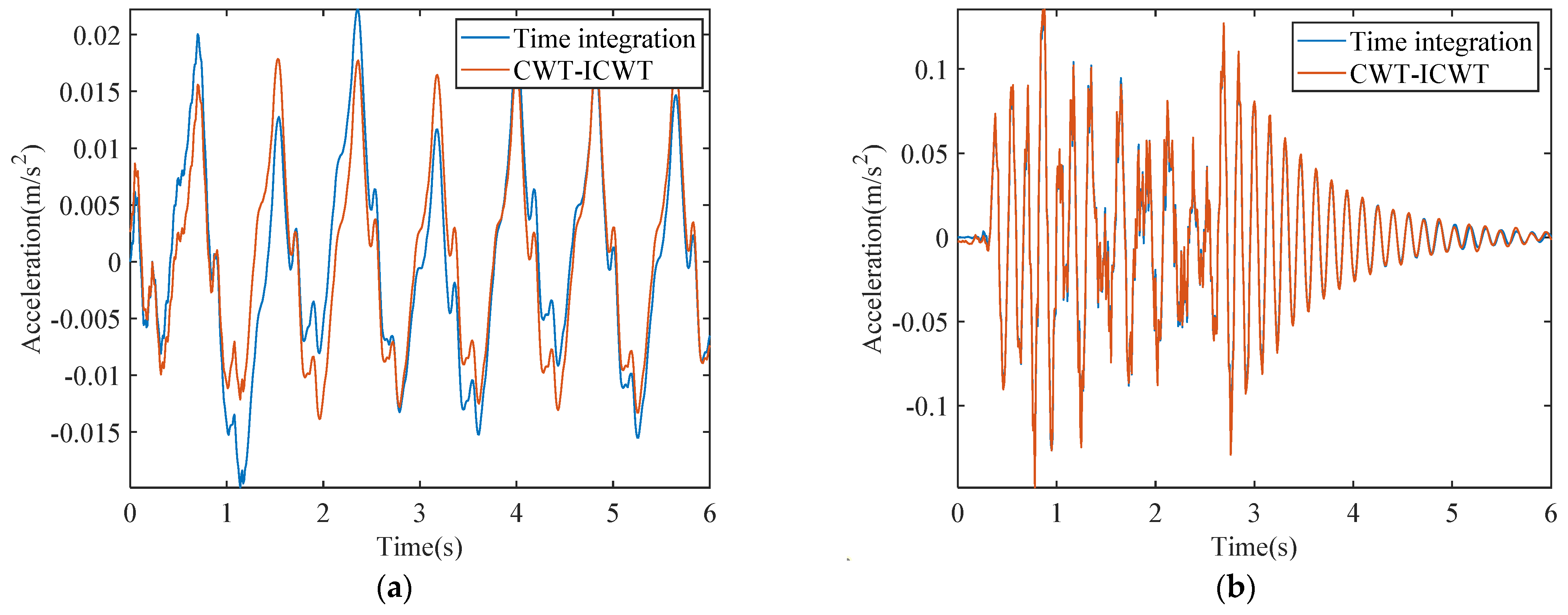
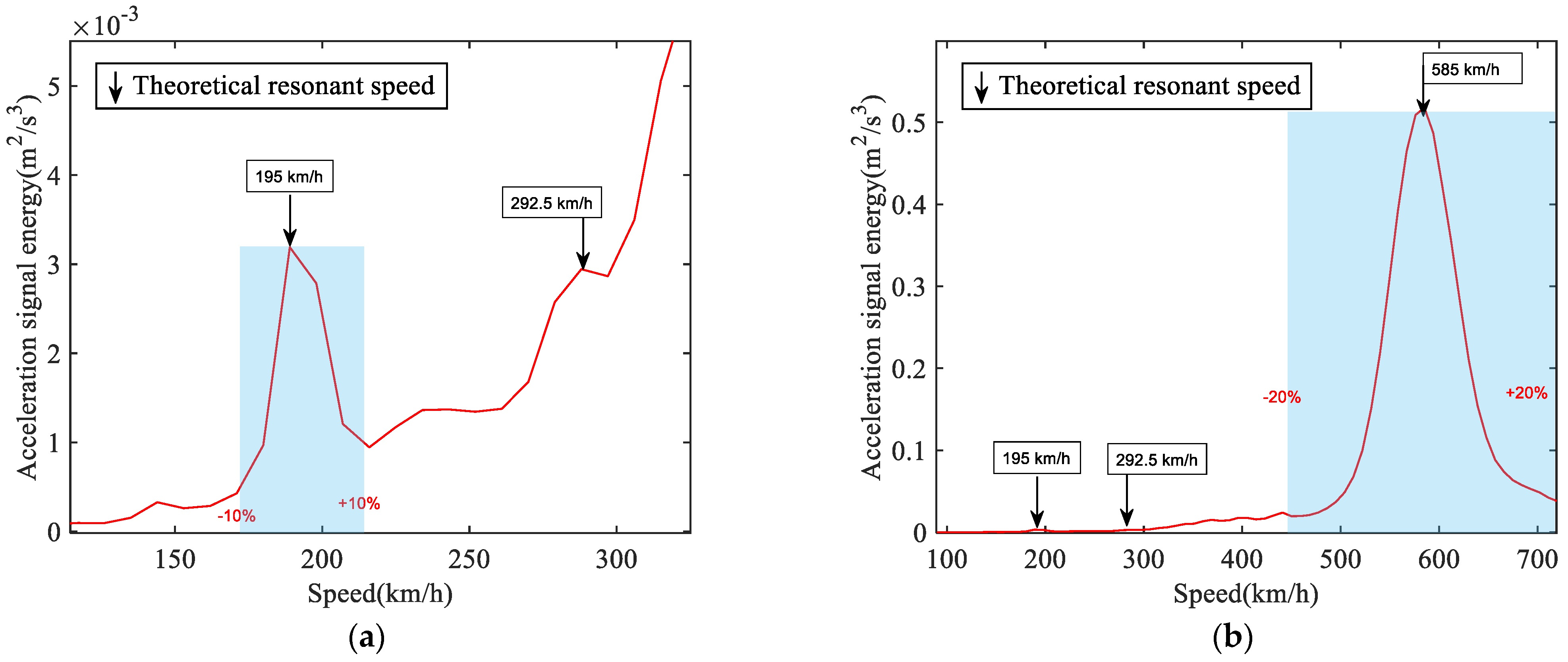
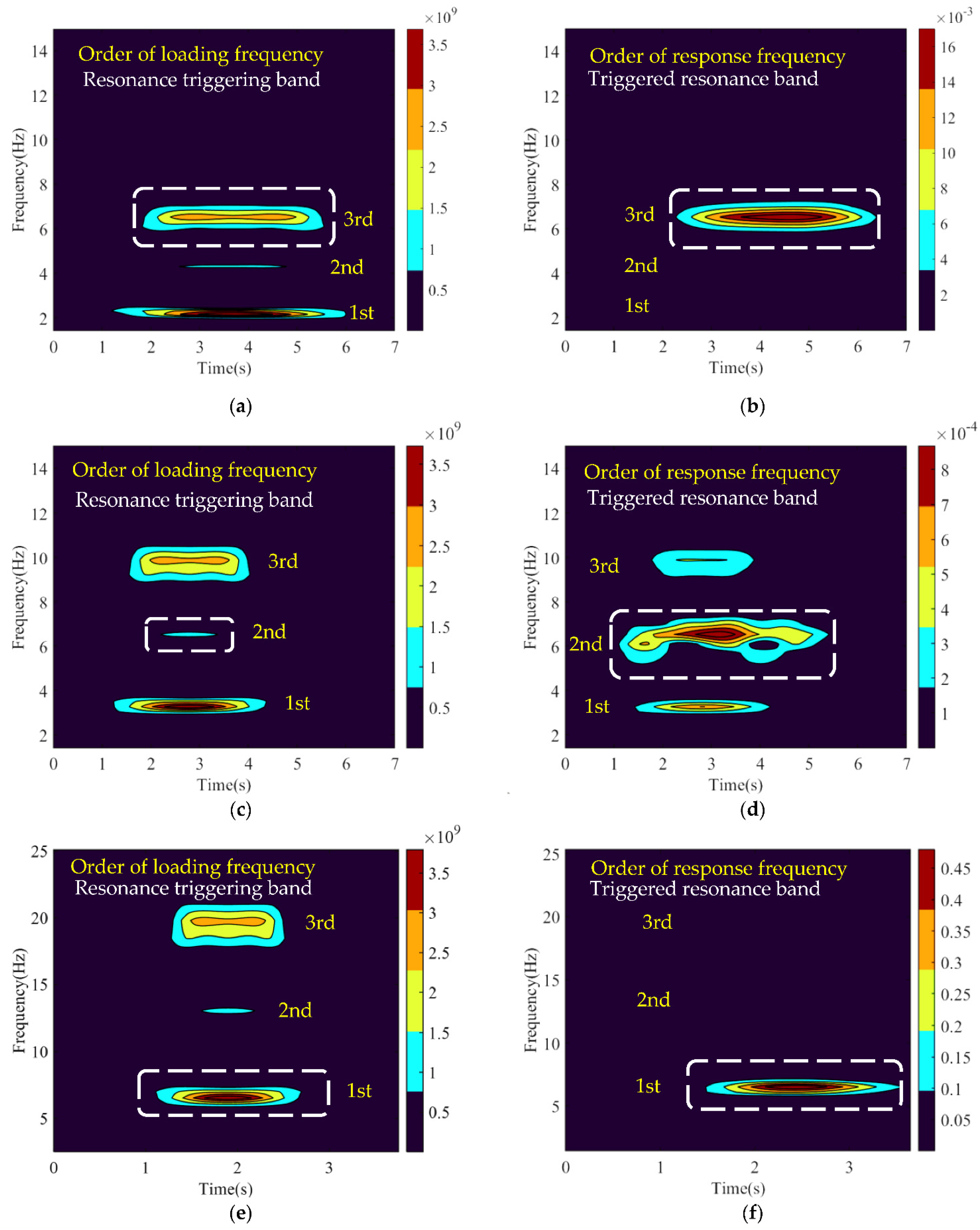
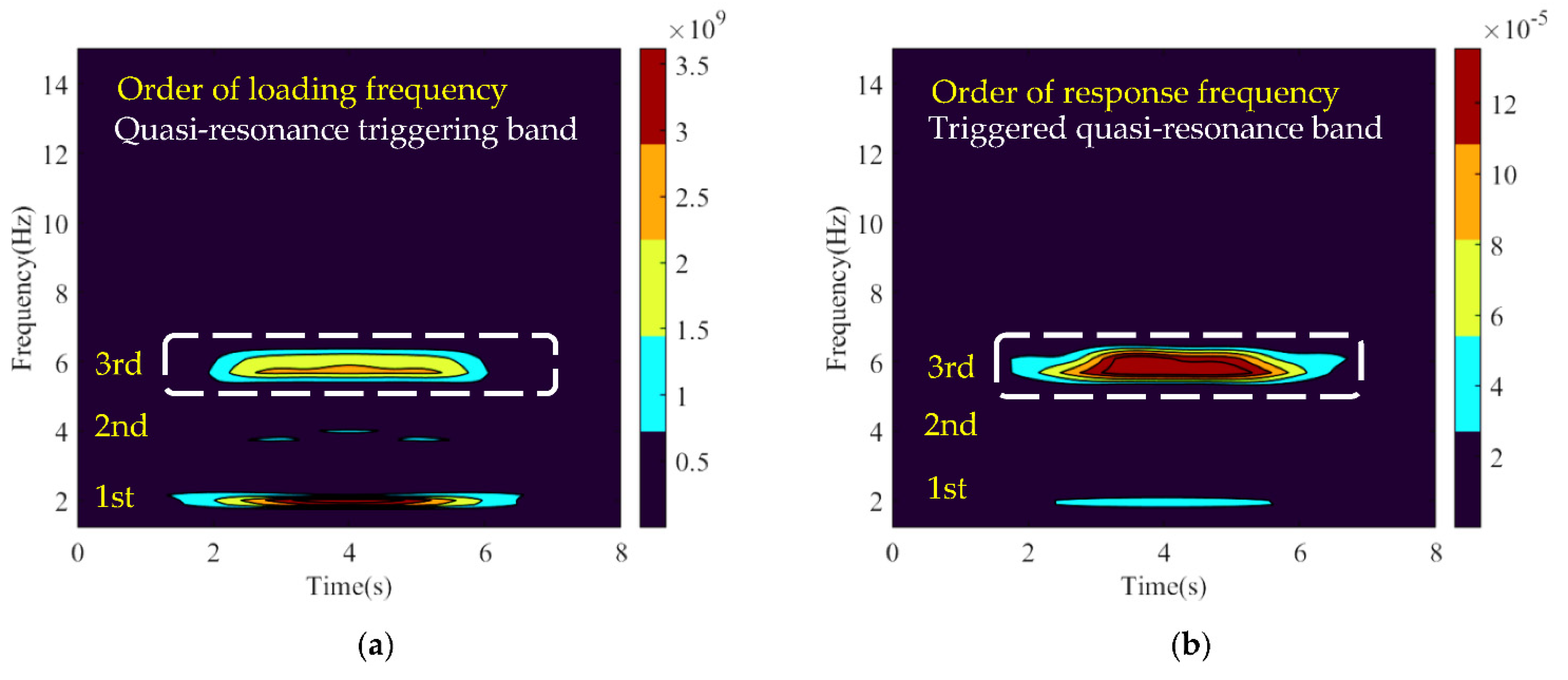

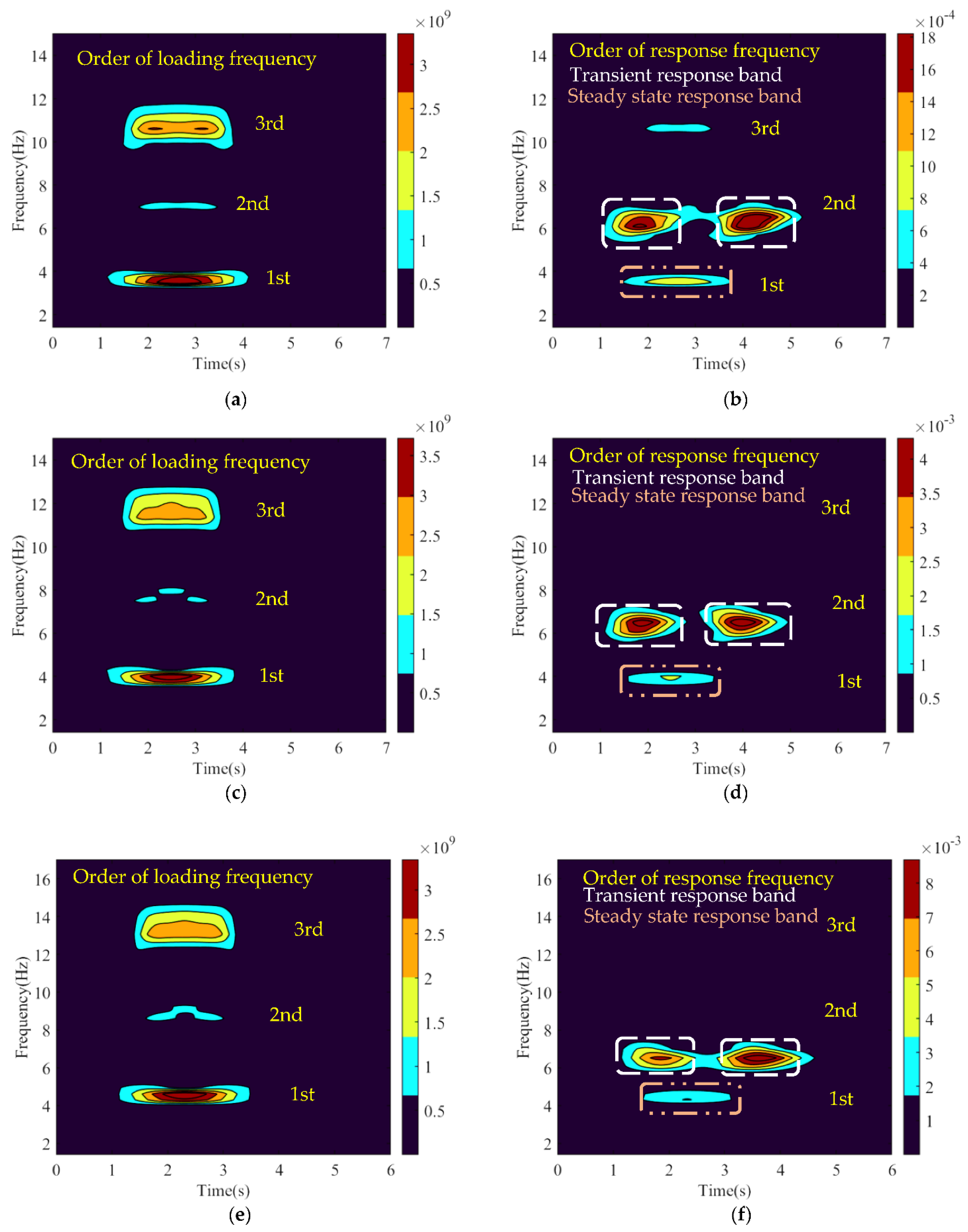

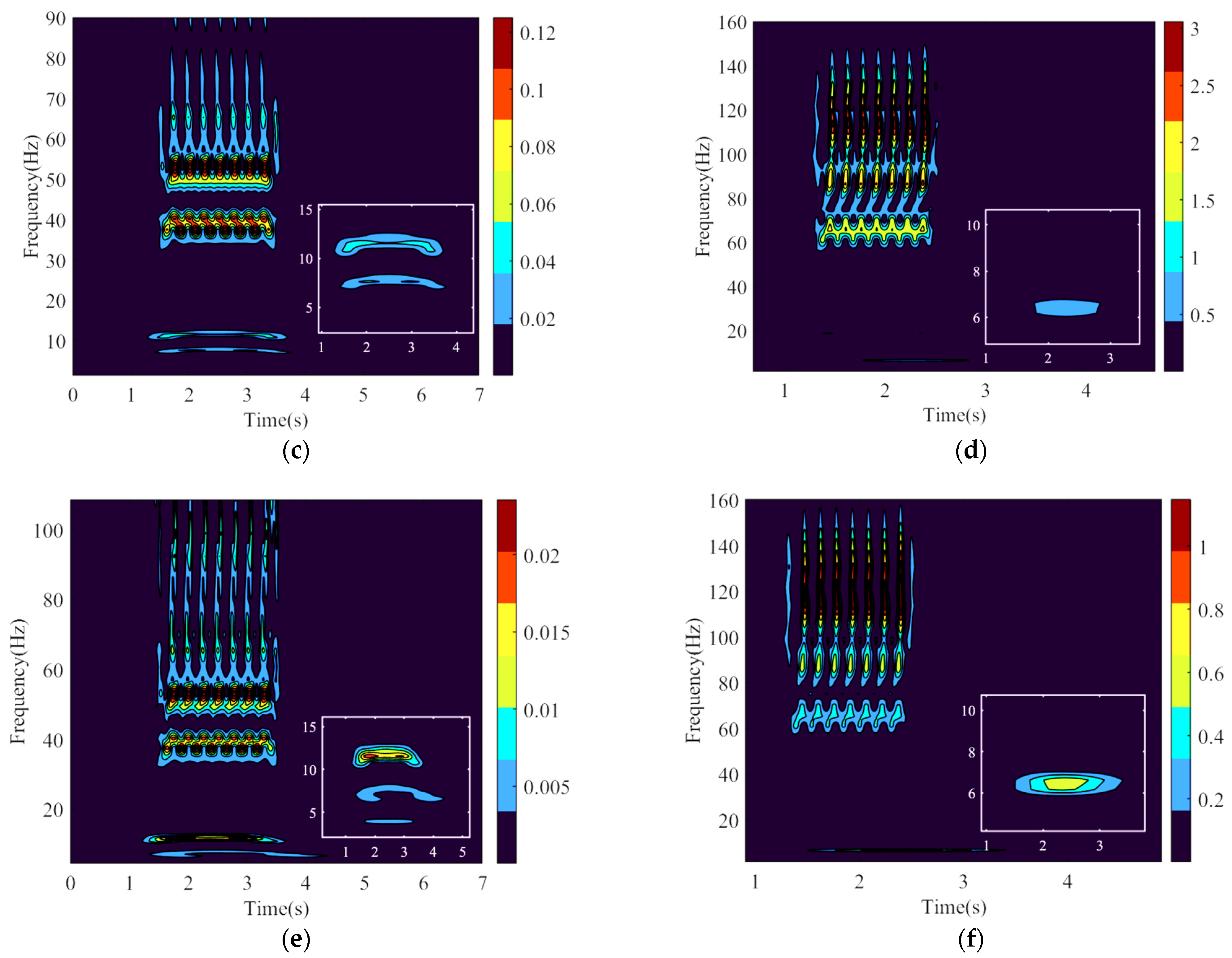
| Train Subsystem Parameter | Value | Unit |
|---|---|---|
| Car body mass mc | 40,000 | kg |
| Bogie mass mb | 3000 | kg |
| Wheel set mass mw | 2000 | kg |
| Car body inertia Ic | 2 × 106 | kg·m2 |
| Bogie inertia IB | 3000 | kg·m2 |
| Primary suspension stiffness k1 | 1 × 106 | N/m |
| Primary suspension damping c1 | 20,000 | N·s/m |
| Secondary suspension stiffness k2 | 2 × 105 | N/m |
| Secondary suspension damping c2 | 10,000 | N·s/m |
| Semi–distance of wheel sets d1 | 1.25 | m |
| Semi–distance of bogies d2 | 8.75 | m |
| Distance of vehicle lv | 25 | m |
| Number of vehicle elements nv | 8 |
| Track–Bridge Subsystem Parameter | Value | Unit |
|---|---|---|
| Rail elastic modulus Er | 2.1 × 1011 | Pa |
| Rail inertia Ir | 3.2 × 10−5 | m4 |
| Rail section area Sr | 7.7 × 10−3 | m2 |
| Rail material density ρr | 7850 | kg/m2 |
| Beam element length of rail lre | 3.2 | m |
| Rail length lr | 96 | m |
| Rail damping ratio ξr | 0.01 | |
| Fastener stiffness kf | 1.2 × 108 | N/m |
| Fastener damping cf | 75,000 | N·s/m |
| Fastener space lf | 0.64 | m |
| Sleeper mass ms | 120 | kg |
| Sleeper space ls | 0.64 | m |
| Ballast stiffness ks | 1.8 × 108 | N/m |
| Ballast damping cs | 5.8 × 104 | N·s/m |
| Bridge elastic modulus Eb | 3.5 × 1010 | Pa |
| Bridge inertia Ib | 22.5 | m4 |
| Bridge section area Sb | 17.5 | m2 |
| Bridge material density ρb | 2500 | kg/m2 |
| Beam element length of bridge lbe | 3.2 | m |
| Bridge length lb | 32 | m |
| Bridge damping ratio ξb | 0.03 |
| Parameters | Value | Unit |
|---|---|---|
| Roughness coefficient Av | 4.032 × 10−7 | m·rad |
| Cutoff angular wave number nr | 0.0206 | rad/m |
| Cutoff angular wave number nc | 0.8246 | rad/m |
| Lower limit of time tmin | 0 | s |
| Upper limit of time tmax | 30 | s |
| 0.001 | s | |
| Arrival instant on the bridge for the first wheel set t0 | 8lv/V | s |
| Lower limit of angular wave number nmin | π/40 | rad/m |
| Upper limit of angular wave number nmax | 2π | rad/m |
| π/400 | rad/m |
Publisher’s Note: MDPI stays neutral with regard to jurisdictional claims in published maps and institutional affiliations. |
© 2022 by the authors. Licensee MDPI, Basel, Switzerland. This article is an open access article distributed under the terms and conditions of the Creative Commons Attribution (CC BY) license (https://creativecommons.org/licenses/by/4.0/).
Share and Cite
Wu, Z.; Zhang, N.; Yao, J.; Poliakov, V. Wavelet Time-Frequency Analysis on Bridge Resonance in Train-Track-Bridge Interactive System. Appl. Sci. 2022, 12, 5929. https://doi.org/10.3390/app12125929
Wu Z, Zhang N, Yao J, Poliakov V. Wavelet Time-Frequency Analysis on Bridge Resonance in Train-Track-Bridge Interactive System. Applied Sciences. 2022; 12(12):5929. https://doi.org/10.3390/app12125929
Chicago/Turabian StyleWu, Zhaozhi, Nan Zhang, Jinbao Yao, and Vladimir Poliakov. 2022. "Wavelet Time-Frequency Analysis on Bridge Resonance in Train-Track-Bridge Interactive System" Applied Sciences 12, no. 12: 5929. https://doi.org/10.3390/app12125929






